Book contents
- The Cambridge Handbook of Social Problems
- The Cambridge Handbook of Social Problems
- Copyright page
- Contents
- About the Contributors
- Introduction
- Part I Problems Related to Health, Safety, and Security
- Part II Problems Related to Crime and Violence
- Chapter 12 The Problem of Crime
- Chapter 13 Corporate Malfeasance as a Social Problem
- Chapter 14 The Construction of School Bullying as a Social Problem
- Chapter 15 Rampage School Shootings
- Chapter 16 Understanding Sexual Violence: The Role of Causal and Precipitating Factors in Sexual Offending
- Chapter 17 Critical and Intersectional Understandings of Campus Sexual Assault as a Social Problem
- Chapter 18 Child Abuse and Neglect
- Chapter 19 Family Violence
- Chapter 20 Juvenile Violence
- Chapter 21 Gangs and Gang Violence
- Chapter 22 State Violence
- Chapter 23 Hate Crime
- Chapter 24 Police Brutality
- Chapter 25 Capital Punishment/Death Penalty
- Chapter 26 Wrongful Convictions: Comparative Perspectives
- Part III Problems of Global Impact
- Index
- References
Chapter 17 - Critical and Intersectional Understandings of Campus Sexual Assault as a Social Problem
from Part II - Problems Related to Crime and Violence
Published online by Cambridge University Press: 16 March 2018
- The Cambridge Handbook of Social Problems
- The Cambridge Handbook of Social Problems
- Copyright page
- Contents
- About the Contributors
- Introduction
- Part I Problems Related to Health, Safety, and Security
- Part II Problems Related to Crime and Violence
- Chapter 12 The Problem of Crime
- Chapter 13 Corporate Malfeasance as a Social Problem
- Chapter 14 The Construction of School Bullying as a Social Problem
- Chapter 15 Rampage School Shootings
- Chapter 16 Understanding Sexual Violence: The Role of Causal and Precipitating Factors in Sexual Offending
- Chapter 17 Critical and Intersectional Understandings of Campus Sexual Assault as a Social Problem
- Chapter 18 Child Abuse and Neglect
- Chapter 19 Family Violence
- Chapter 20 Juvenile Violence
- Chapter 21 Gangs and Gang Violence
- Chapter 22 State Violence
- Chapter 23 Hate Crime
- Chapter 24 Police Brutality
- Chapter 25 Capital Punishment/Death Penalty
- Chapter 26 Wrongful Convictions: Comparative Perspectives
- Part III Problems of Global Impact
- Index
- References
Summary
Sexual violence on college and university campuses raises multidimensional issues for public health, public safety, criminal justice, and civil rights. This chapter will examine the factors that complicate both measuring and effectively addressing campus sexual assault as a social problem, by outlining the challenges presented by defining (1) the terms used to measure prevalence rates, (2) the extremely low rates at which instances of campus sexual violence are reported to authorities, (3) the particular aspects of college and university contexts that are specifically associated with sexual assault risks, and (4) the sociohistorical legacies of contestation that inform broader contemporary understandings of sexual violence at the intersections of race, gender, sexuality, class, and other social identity dynamics.
- Type
- Chapter
- Information
- The Cambridge Handbook of Social Problems , pp. 287 - 308Publisher: Cambridge University PressPrint publication year: 2018
References
- 1
- Cited by



